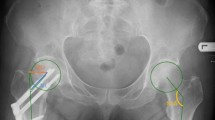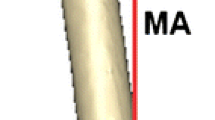Abstract
Purpose
When the lateral offset (LO) changes, the forces acting on the head and neck of the femur change. Increase or decrease in LO can cause instability and possible dislocation of the implant. In addition, when the offset is reduced, more force is needed to balance the pelvis by the abductor muscles, and the force that occurs along the hip joint increases and causes wear and tear. In this study we aimed to investigate whether there is a correlation between LO and proximal femur morphology, and according to the results we aimed to investigate whether the LO can be used as a predictive marker for the risk of femoral neck fractures, osteoarthritis or femoroacetabular impingement.
Methods
Femur length, femur neck length, femoral neck–shaft angle (NSA), anteroposterior (a–p) and superoinferior (s–i) diameters of femoral head and neck, and LO were measured on 82 dry adult femora of unknown age and gender from Turkish population.
Results
There was no statistically significant correlation between the LO and a–p and s–i diameters of femoral head or neck. However, there was found statistically significant correlation between LO and femoral NSA (p < 0.01), femoral neck length (p < 0.05) and femur length (p < 0.01).
Conclusion
High LO values can be used as an indicator for neck fractures, a negative marker for OA, but LO does not appear to be used as an indicator for FAI.



Similar content being viewed by others
References
Piriou, P., Bugyan, H., Casalonga, D., Lizee, E., Trojani, C., & Versier, G. (2013). Can hip anatomy be reconstructed with femoral components having only one neck morphology? A study on 466 hips. The Journal of arthroplasty., 28, 1185–1191.
Noble, P. C., Alexander, J. W., Lindahl, L. J., Yew, D. T., Granberry, W. M., & Tullos, H. S. (1988). The anatomic basis of femoral component design. Clinical Orthopaedics and Related Research, 235, 148.
Davies, H., Foote, J., & Spencer, R. F. (2007). Accuracy of femoral templating in reproducing anatomical femoral offset in total hip replacement. Hip International, 17, 155.
Lecerf, G., Fessy, M. H., Philippot, R., et al. (2009). Femoral offset: Anatomical concept, definition, assessment, implications for preoperative templating and hip arthroplasty. Orthopaedics & traumatology, surgery & Research: OTSR., 95, 210–219.
Sariali, E., Mouttet, A., Pasquier, G., & Durante, E. (2009). Three-dimensional hip anatomy in osteoarthritis. Analysis of the femoral offset. The Journal of Arthroplasty., 24, 990–997.
Sugano, N., Noble, P. C., & Kamaric, E. (1999). Predicting the position of the femoral head center. The Journal of arthroplasty., 14, 102.
Dolhain, P., Tsigaras, H., Bourne, R. B., Rorabeck, C. H., Mac Donald, S., & Mc, C. R. (2002). The effectiveness of dual offset stems in restoring offset during total hip replacement. Acta Orthopaedica Belgica, 68, 490.
Bourne, R. B., & Rorabeck, C. H. (2002). Soft tissue balancing: The hip. The Journal of arthroplasty., 17, 17–22.
Padgett, D. E., & Warashina, H. (2004). The unstable total hip replacement. Clinical Orthopaedics, 420, 72–79.
Önal, A. (2013). Kalça eklemi biyomekaniği ve artroplasti uygulamaları. TOTBID Dergisi., 12, 197–200.
Burzynski, S., Sabik, A., Witkowski, W., & Łuczkiewicz, P. (2021). Influence of the femoral offset on the muscles passive resistance in total hip arthroplasty. PLoS ONE, 16(5), e0250397.
Doherty, M., Courtney, P., Doherty, S., et al. (2008). Nonspherical femoral head shape (pistol grip deformity), neck shaft angle, and risk of hip osteoarthritis: A case-control study. Arthritis and rheumatism., 58, 3172–3182.
Javaid, M. K., Lane, N. E., Mackey, D. C., et al. (2009). Changes in proximal femoral mineral geometry precede the onset of radiographic hip osteoarthritis: The study of osteoporotic fractures. Arthritis and rheumatism., 60, 2028–2036.
Johnson, J. K., Renner, J. B., & Dahners, L. E. (2012). Anteroposterior thickening of the femoral neck with aging decreases the “offset” in men. The American journal of sports medicine., 40, 2213–2217.
Duboeuf, F., Hans, D., Schott, A. M., et al. (1997). Different morphometric and densitometric parameters predict cervical and trochanteric hip fracture The EPIDOS Study. Journal of Bone and Mineral Research, 12, 1895–1902.
Gluer, C. C., Cummings, S. R., Pressman, A., et al. (1994). Prediction of hip fractures from pelvic radiographs The study of osteoporotic fractures. Journal of Bone and Mineral Research, 9, 671–677.
Gnudi, S., Ripamonti, C., Lisi, L., et al. (2002). Proximal femur geometry to detect and distinguish femoral neck fractures from trochanteric fractures in postmenopausal women. Osteoporosis International, 13, 69–73.
Beall, D. P., Sweet, C. F., Martin, H. D., et al. (2005). Imaging findings of femoroacetabular impingement syndrome. Skeletal Radiology., 34, 691–701.
Jacobsen, S., Sonne-Holm, S., Soballe, K., Gebuhr, P., & Lund, B. (2004). Radiographic case definitions and prevalence of osteoarthrosis of the hip: A survey of 4 151 subjects in the Osteoarthritis Substudy of the Copenhagen City Heart Study. Acta orthopaedica Scandinavica., 75, 713–720.
Murray, R. O. (1965). The aetiology of primary osteoarthritis of the hip. British Journal of Radiology, 38, 810–824.
Reikeras, O., & Hoiseth, A. (1982). Femoral neck angles in osteoarthritis of the hip. Acta orthopaedica Scandinavica., 53, 781–784.
Partanen, J., Jamsa, T., & Jalovaara, P. (2001). Influence of the upper femur and pelvic geometry on the risk and type of hip fractures. Journal of Bone and Mineral Research, 16, 1540–1546.
Karlsson, K. M., Sernbo, I., Obrant, K. J., Redlund-Johnell, I., & Johnell, O. (1996). Femoral neck geometry and radiographic signs of osteoporosis as predictors of hip fracture. Bone, 18, 327–330.
Ferris, B. D., Kennedy, C., Bhamra, M., & Muirhead-Allwood, W. (1989). Morphology of the femur in proximal femoral fractures. The Journal of Bone and Joint Surgery British Volume., 71 A, 475–477.
Blumel, S., Stadelmann, V. A., Brioschi, M., Küffer, A., Leunig, M., & Rüdiger, H. A. (2021). The trochanteric double contour is a valuable landmark for assessing femoral offset underestimation on standard radiographs: A retrospective study. BMC Musculoskeletal Disorders, 22(1), 310.
Kawamura, H., Watanabe, Y., Nishino, T., & Mishima, H. (2021). Effects of lower limb and pelvic pin positions on leg length and offset measurement errors in experimental total hip arthroplasty. Journal of Orthopaedic Surgery and Research, 16(1), 193.
Berend, K. R., Sporer, S. M., Sierra, R. J., Glassman, A. H., & Morris, M. J. (2010). Achieving stability and lower-limb length in total hip arthroplasty. The Journal Of Bone & Joınt Surgery., 92 A, 2737–2752.
Flecher, X., Ollivier, M., & Argenson, J. N. (2016). Lower limb length and offset in total hip arthroplasty. Orthopaedics & Traumatology: Surgery & Research., 102, 9–20.
Hsieh, C. M., Howell, S. M., & Hull, M. L. (2020). Errors in femoral anteversion, femoral offset, and vertical offset following robot-assisted total hip arthroplasty. The international journal of medical robotics + computer assisted surgery: MRCAS., 16, 2104.
Clark, J. M., Freeman, M. A. R., & Witham, D. (1987). The relationship of neck orientation to the shape of the proximal femur. The Journal of Arthroplasty, 2(2), 99–109.
Alpert, B. (1998). Tall stature. Pediatrics in Review, 19(9), 303.
Zargham, S., & Crotty, J. E. (2014). Tall stature. Pediatrics in Review, 35, 538.
Barstow, C., & Rerucha, C. (2015). Evaluation of short and tall stature in children. American Family Physician, 92(1), 43–50.
Yamauchi, K., Naofumi, M., Sumida, H., Fukuta, S., & Hori, H. (2016). Comparison of morphological features in the femur between femoral neck fractures and femoral intertrochanteric fractures. Surgical and Radiologic Anatomy: SRA., 38, 775–780.
Michelotti, J., & Clark, J. (1999). Femoral neck length and hip fracture risk. Journal of Bone and Mineral Research, 14, 1714–1720.
Pasquier, G., Ducharne, G., Ali, E. S., Giraud, F., Mouttet, A., & Durante, E. (2010). Total hip arthroplasty offset measurement: Is CT scan the most accurate option? Orthopaedics & Traumatology, Surgery & Research: OTSR., 96, 367–375.
Than, P., Szuper, K., Somoskeoy, S., Warta, V., & Illes, T. (2012). Geometrical values of the normal and arthritic hip and knee detected with the EOS imaging system. International Orthopaedics, 36, 1291–1297.
Acknowledgements
The authors thank to Selcen Yüksel (M.Sc., Ph.D.) Assoc. Prof., Dept. of Biostatistics, for their valuable contributions running the statistical analysis of this study.
Funding
The authors received no financial support for the research, authorship, and/or publication of this article.
Author information
Authors and Affiliations
Corresponding author
Ethics declarations
Conflict of interest
The authors declare that there is no conflict of interest.
Ethical standard statement
This article does not contain any studies with human or animal subjects performed by the any of the authors.
Informed consent
For this type of study informed consent is not required.
Additional information
Publisher's Note
Springer Nature remains neutral with regard to jurisdictional claims in published maps and institutional affiliations.
Rights and permissions
About this article
Cite this article
Torun, B.İ., Kendir, S., Geneci, F. et al. Can Lateral Offset Be Used as a Predictive Marker for Proximal Femur Disorders?. JOIO 56, 614–620 (2022). https://doi.org/10.1007/s43465-021-00576-2
Received:
Accepted:
Published:
Issue Date:
DOI: https://doi.org/10.1007/s43465-021-00576-2




